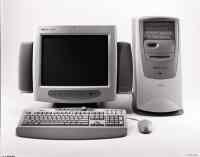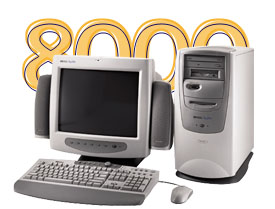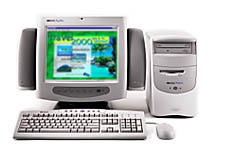|
|


TechnoFILE is copyright and a registered trademark © ® of
Pandemonium Productions.
All rights reserved.
E-mail us Here!

Visiting the HP PavilionBy Jim Bray Everyone knows that Hewlett Packard sells truckloads of computer peripherals, from inkjet and laser printers to scanners and digital cameras. Well it appears the folks at HP are also intent on selling truckloads of PC's to which peripherals can be hooked, if the pavilions 8595C, 8490, 8380 and 4450 are any indication. The highest end of these is the 8595C, a Pentium III powerhouse that rockets along at 733 MHz (with a 133 Mhz front side bus) and includes enough other goodies to keep the office or home office worker busy and happy. Not only that, but it'll satisfy graphics designers and serious gamers, too. In short, if you have the bucks, this PC has the horsepower. The 8595C ($2199US) is a lower profile unit than some of the models on this page, but despite that HP hasn't scrimped on a thing. Not only is the processor high end and high speed, but you get 128 MB of SDRAM (upgradeable to 384MB), a built in network card, DVD ROM drive, CD-RW drive, and more. Oh, and a more than generous, 36 Gigabyte (yes, that's 36 GIG!) ultra DMA hard drive, which is huge, and about as fast as one could expect short of going "warp speed" SCSI. The HP CD-Writer Plus lets you "burn" your own CD's, and the included Adaptec software works well, though it's a mite ponderous. The DVD drive is an 8X speed performer, and you should see the speed with which it installs software! Its performance on DVD movies is also first rate. The video performance comes courtesy of an 8MB nVIDIA Vanta 3D AGP video card, which is one heck of a performer. We found it made the Pavilion our best games testbed yet, and the hardware-intensive "Star Wars Episode One Pod Racer" game screamed along as happily as a pig in you know what on this system, performing better than on any other system we've tested to date. As is HP's recent wont, the 8595C has a front mounted serial port for your digital camera - only this time the company has gone itself one better and added a USB port to the front as well. Both ports are mounted, side by side, behind a little plastic door that covers up the cavity when not in use. There's another cavity on top of the unit, a place where you can store CD's. This seems a little strange, in it won't hold too many discs, but what the hell - it's unique and thoughtful and one, like cup holders and storage bins in your car, you can never have too much storage space. The network card is of the 10/100 BaseT persuasion and hooked into and performed over our home network flawlessly. Its inclusion was an unexpected bonus, and we applaud HP for thinking of it. The 8595C is a terrific performer, though when we unpacked it it left a lot to be desired. This could have been due to the system being corrupted by a previous media user, however, because once we used HP's included recovery disk to put the system back to its "square one" configuration it worked really well. On the more mundane front, the system comes with a v.90 56K modem and the typical HP keyboard that, while not offering the best typing feel, has a slew of buttons and controls mounted on it to handle multmedia, Internet, and document management tasks. There's also a standby button to save power, and a one touch help system and even a scrolling, "IntelliMouse-compatible," mouse. One thing we noticed with this HP, and with some others we've tried, is its lack of a "reset" switch. This is a shame because, Windows being what it is, we need to show the system who's boss periodically. With the HP's this means unplugging the power cord from the rear and plugging it back in again - not a big deal, but a bigger deal than just slapping a "reset" button. Still, that's a very minor criticism. Software bundled with the system includes Windows 98, Microsoft Works (we were suprised that Office wasn't installed on such a powerhouse system), Quicken Basic '99, Microsoft Money 99, and Smith/Micro Quicklink III Fax Software. There's also a bunch of education/reference/entertainment stuff, including Microsoft Encarta 99 Encyclopedia, At Home Disney's Daily Blast online service for kids and a bunch of other online services access. Even if all this software isn't your cup of tea, there's enough room on the hard drive to store a horse, so to speak. In the review below, we noted some question over the Pentium III processor but must point out that we had no problems with the one in the 8595C, so perhaps it was an aberration. However you slice it, if you have the entry fee for this PC (and considering what PC's cost only a couple of years ago the admission isn't onerous) the Pavilion 8595C will keep you happy chugging away right up until the next major upgrade comes along - and maybe beyond. The Pavilion 8490 ($2499US, $3999 Cdn), is a Pentium III-powerhouse that not only screams along at a healthy 500 Mhz, it offers a built-in DVD ROM drive and a built in CD writer. It's quite the package! But is there a technological price to pay? The 8490 boasts of a 100 MHz front side bus and 128 MB of SDRAM, so it should keep you going for a while. The hard drive is a big 19 GB and you also get a V.90 K56flex data/fax modem. Video graphics are courtesy of ATI's RagePro Turbo and there's an AGP slot on the motherboard so you can upgrade the system down the road. Video memory is 8MB SDRAM. ATI also provides the MPEG MPEG2 full-motion digital video DVD player. Sound comes from a pair of Polk Audio Stereo Speakers like those that accompany the other Pavilions reviewed on this page. HP also includes its One-touch multimedia keyboard, which has volume and playback controls for your CD's or DVD's - as well as buttons for directly accessing Internet features. It isn't a bad keyboard on which to type, though I prefer a little more "click" in my keys than this keyboard provides. The Mouse is 2-button "scrolling" mouse a la MS Intellimouse. I love the scroll wheel and don't know how I could live without one. There's a pretty good selection of expansion slots: 1 ISA, 4 PCI, and the aforementioned 1 AGP. You also get 2 USB ports, 1 serial and 1 parallel, and a game port. A nice touch is the placement of a serial port on the front of the unit, where you can hook in a digital camera easily. Software includes Microsoft Windows 98, Microsoft Works, Quicken 99, Microsoft Money 99, HP's Financial Calculator, and Smith/Micro Quicklink III Fax Software. As if that weren't enough, they also pack the hard drive (well, there's still lots of room for your stuff!) Microsoft Encarta 99 Encyclopedia, and a bunch of utilities, helpers, and online service connections. For creating your CD's, there's HP CD-Writer HP Simple Trax and Adaptec's Easy CD Creator & DirectCD. And for those times when your hard drive goes "Bye Bye," HP's Disaster Recovery CD restores it to its initial pristine state. As mentioned earlier, the HP Pavilion 8490 comes HP's CD-Writer Plus built in, and that's a wonderful touch. The first thing I did with it was gather together all my personal files - dating back to about 1989 - and archive them onto a CD-ROM, where they'll now remain forever, an insurance policy against hard drive crashes, operator stupidity, and world war. Okay, maybe not world war... I used the first archive to back up a second and store that one at a friend's home; now my place can burn down and I'll still have a backup of my important old stuff. Naturally, you can also hoist the "jolly roger" flag over your home office and create your own music CD's. I tried this to create a "best of" collection from some of my audio CD's, and it works really well. Remember, however, it's illegal to pirate audio CD's and games, so it's best to use the "dark side of the force" potential of this tool reasonably, fairly, and intelligently. Making a compilation of your own music CD's for your own use is probably okay (as long as you're not selling copies), but straight pirating is a no no. The DVD ROM drive is fast and works well. ATI's software DVD player does a pretty good job, too, as both a CD-ROM reader and DVD/movie player. I had a pretty big problem with using the Pavilion 8490 when I first unpacked it. It had been tested by a media outlet before TechnoFILE (those bounders!), and perhaps hadn't been restored before being sent my way. Whatever the reason, when I fired the unit up and started using it, it was horribly unstable - crashing and locking up so often I was ready to pound it into rubble. After using the emergency restore disc, however, the situation improved immeasurably and the PC became - for the most part - a real pleasure to use. There was still some instability, however, enough to make me think this Pentium III unit may not be as solid as the other PC's reviewed on this page. There were still some strange lockups and crashes, and sometimes a reboot would hang up halfway through and I'd have to reboot while it was rebooting (which is pretty weird). Fortunately, this was the exception rather than the rule - for the most part - though it was certainly frustrating. On the whole, however, the 8490 is a very nice performer - fast and powerful enough for heavy duty apps and resource-intensive games. It has more than enough "poop" for most people, and comes with enough hardware and software performance to please just about anyone but the most heavy duty user.
All of which explains the $2800 price tag. What's in this HP explains why one spends that amount when you can get a PC for a grand these days. HP packs the 8380 with as much stuff as one could want. Besides the abovementioned stuff, there's an Ensoniq AudioPCI "3D" sound card, a decent set of Polk Audio speakers, AGP 2x video performance courtesy of ATI's Rage Pro Turbo with 8 Meg of memory, and a set of handy controls for sound and media control mounted right on the keyboard. I/O's include the usual parallel and serial ports, with 2 USB ports and a TV out connector thrown in for good measure. You even get an extra, front-mounted, "digital camera port" that, if it were on the rear of the unit, would be called yet another serial port. Inside the 8380 are six bays and five slots, so the unit's quite expandable as well. HP even throws in (well, includes with the price) a reasonable bundle of software. You get Windows 98 as the operating system, Microsoft Word 97 word processor and MS Works 4.5 for your productivity suite. There's also Encarta 98, Quicken Basic and Microsoft Money (which seem a bit redundant), Picture It 2.0 for those digital pictures you can so easily download from the optional camera, and a DVD version of Africa the Serengeti. The latter's a nice touch, 'cause there just aren't very many DVD titles out yet that aren't movies, and many people may find it hard to justify killing time on the PC's watching Hollywood flicks. Oh, yeah, there's the usual telephony stuff and a bunch of utilities and Internet access features designed to help make logging on as painless as possible. HP has even, quite thoughtfully, included a handy personal guide of hints and tips for working and living with your Pavilion. All the stuff seems to work as advertised. Hooking up the computer is about as easy as any other - and maybe a bit easier because HP colour codes some of the connectors to make them virtually bozo proof. Using it is also as pleasurable an experience as I've had from most PC's. I had the requisite number of strange crashes and spontaneous reboots, but no more than I get from my own computer. My one real complaint was the feel of the keyboard, which I found mushy and difficult on which to make good typing speed. It was no worse than most "standard equipment" keyboards, however, and my complaint is as much due to my being a keyboard snob as to any shortcoming on the part of Messers Hewlett and Packard. So on the whole, this HP Pavilion is a fine unit in a handsome case. It's admittedly pricey compared to more entry level units, but considering all the stuff crammed into the box, HP's reputation for quality and support, it's not overpriced. But now I dread going back to the 300 MHz unit I bought a scant 6 months ago!
Closer to the other end
of the spectrum is Hp's Pavilion 4450. This $1400Cdn (sans monitor) unit
is a cutey; the case is scarcely higher than a couple of shoe boxes piled
atop each other, but inside there's enough computer for the average home
user - as long as you don't want to get into heavy duty gaming.
|
|
|
|
|
| Support TechnoFile via Paypal |
| TechnoFILE's
E-letter We're pleased to offer our FREE private, subscription-based private E-mail service. It's the "no brainer" way to keep informed. Our Privacy Policy |
 The Pavilion 8380 (about
$2800Cdn, sans monitor) is a smaller, slower rocket - but a rocket nonetheless.
It features a 400 MHz Intel Pentium II MMX running through a 100 MHz bus,
96 Meg of SDRAM, an 8 gig hard drive that even I couldn't fill (though
I only had the thing for a month!), a v.90 56k voice/fax/modem, and even
a DVD drive with ATI's MPEG2 playback software that works really well
with DVD movies.
The Pavilion 8380 (about
$2800Cdn, sans monitor) is a smaller, slower rocket - but a rocket nonetheless.
It features a 400 MHz Intel Pentium II MMX running through a 100 MHz bus,
96 Meg of SDRAM, an 8 gig hard drive that even I couldn't fill (though
I only had the thing for a month!), a v.90 56k voice/fax/modem, and even
a DVD drive with ATI's MPEG2 playback software that works really well
with DVD movies. Diminutive Droid
Diminutive Droid